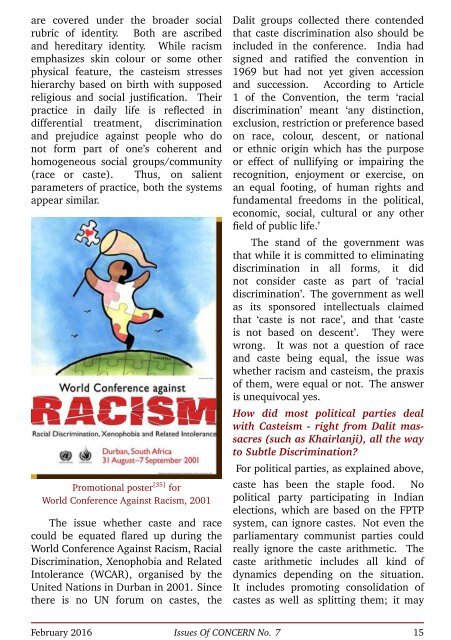ISSUES OF CONCERN
Issues_of_Concern_February_2016
Issues_of_Concern_February_2016
You also want an ePaper? Increase the reach of your titles
YUMPU automatically turns print PDFs into web optimized ePapers that Google loves.
are covered under the broader social<br />
rubric of identity. Both are ascribed<br />
and hereditary identity. While racism<br />
emphasizes skin colour or some other<br />
physical feature, the casteism stresses<br />
hierarchy based on birth with supposed<br />
religious and social justification. Their<br />
practice in daily life is reflected in<br />
differential treatment, discrimination<br />
and prejudice against people who do<br />
not form part of one’s coherent and<br />
homogeneous social groups/community<br />
(race or caste). Thus, on salient<br />
parameters of practice, both the systems<br />
appear similar.<br />
Promotional poster [35] for<br />
World Conference Against Racism, 2001<br />
The issue whether caste and race<br />
could be equated flared up during the<br />
World Conference Against Racism, Racial<br />
Discrimination, Xenophobia and Related<br />
Intolerance (WCAR), organised by the<br />
United Nations in Durban in 2001. Since<br />
there is no UN forum on castes, the<br />
Dalit groups collected there contended<br />
that caste discrimination also should be<br />
included in the conference. India had<br />
signed and ratified the convention in<br />
1969 but had not yet given accession<br />
and succession. According to Article<br />
1 of the Convention, the term ‘racial<br />
discrimination’ meant ‘any distinction,<br />
exclusion, restriction or preference based<br />
on race, colour, descent, or national<br />
or ethnic origin which has the purpose<br />
or effect of nullifying or impairing the<br />
recognition, enjoyment or exercise, on<br />
an equal footing, of human rights and<br />
fundamental freedoms in the political,<br />
economic, social, cultural or any other<br />
field of public life.’<br />
The stand of the government was<br />
that while it is committed to eliminating<br />
discrimination in all forms, it did<br />
not consider caste as part of ‘racial<br />
discrimination’. The government as well<br />
as its sponsored intellectuals claimed<br />
that ‘caste is not race’, and that ‘caste<br />
is not based on descent’. They were<br />
wrong. It was not a question of race<br />
and caste being equal, the issue was<br />
whether racism and casteism, the praxis<br />
of them, were equal or not. The answer<br />
is unequivocal yes.<br />
How did most political parties deal<br />
with Casteism - right from Dalit massacres<br />
(such as Khairlanji), all the way<br />
to Subtle Discrimination?<br />
For political parties, as explained above,<br />
caste has been the staple food. No<br />
political party participating in Indian<br />
elections, which are based on the FPTP<br />
system, can ignore castes. Not even the<br />
parliamentary communist parties could<br />
really ignore the caste arithmetic. The<br />
caste arithmetic includes all kind of<br />
dynamics depending on the situation.<br />
It includes promoting consolidation of<br />
castes as well as splitting them; it may<br />
February 2016 Issues Of <strong>CONCERN</strong> No. 7 15


